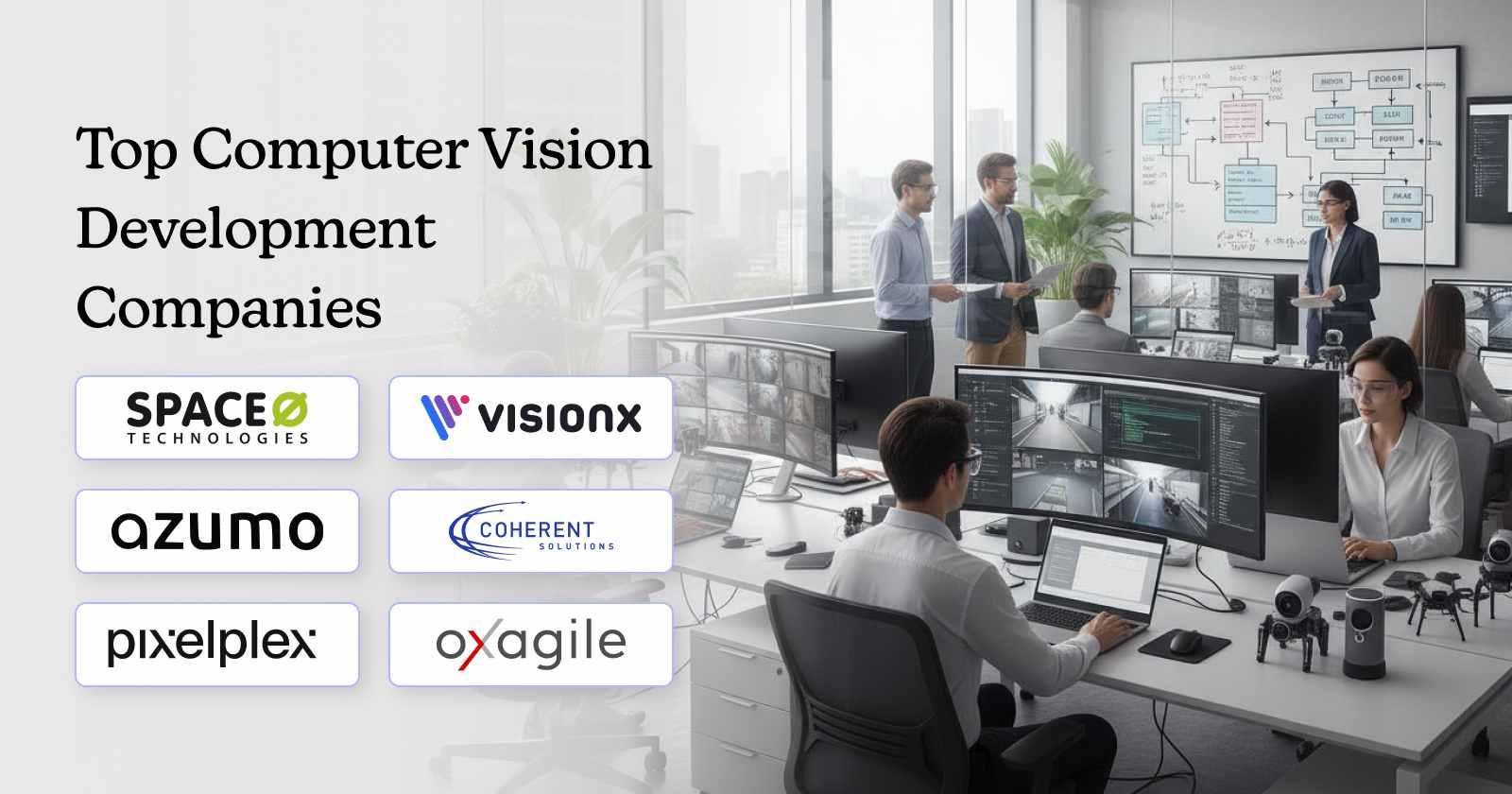
Choosing the right computer vision development partner can feel like navigating a maze. Hundreds of companies claim expertise in AI and computer vision, but separating real technical skill from marketing hype is no easy task. Some excel at facial recognition but struggle with real-time processing. Others have impressive portfolios but can’t scale with your business.
Making the wrong choice doesn’t just waste budget; it can delay your project by months or even derail it entirely. With the global computer vision market reaching $23.62 billion in 2025 and projected to hit $58.29 billion by 2030 (Grand View Research), selecting the right partner has never been more crucial.
We’ve analyzed Clutch profiles, verified client reviews, and the technical capabilities of the top computer vision development companies to bring you the 10 best options. Whether you need facial recognition, automated inspection, or real-time object detection, this guide will help you find the partner that fits your needs.
Our team analyzed over 100 computer vision software development companies, examining their portfolios, client reviews, technical capabilities, and real-world project outcomes. Here’s exactly what we looked for:
After this extensive evaluation, we narrowed down the list to these 10 standout partners. Next, let’s explore each computer vision development agency’s capability and find out which of them is the best partner to hire computer vision developers.
Here’s a quick overview of the top computer vision development companies that stand out for their technical expertise, innovation, and proven project success:
Here’s a quick overview of the top computer vision development companies that stand out for their technical expertise, innovation, and proven project success:
| Company | Clutch Rating | Min. Project Size | Location |
|---|---|---|---|
| 4.8/5 | $10,000+ | Tempe, AZ, USA | |
| 4.9/5 | $25,000+ | New York, USA | |
| 4.8/5 | $50,000+ | London, UK | |
| 4.9/5 | $10,000+ | San Francisco, CA | |
| 4.9/5 | $50,000+ | Minneapolis, MN | |
| 4.9/5 | $25,000+ | New York, USA | |
| 4.8/5 | NA | New York, USA | |
| 4.9/5 | $50,000+ | San Francisco, CA | |
| 4.8/5 | $100,000+ | Florida, USA | |
| 4.8/5 | $75,000+ | Nicosia, Cyprus |
Now that you’ve seen the top computer vision development agencies and their key details, let’s dive into what makes each of these companies unique and how they can help solve your specific computer vision challenges.
Build Your Next Vision-Powered Solution with Experts
Turn your AI ideas into reality with Space-O AI. From model training to full-scale deployment, we help you accelerate innovation securely and efficiently.
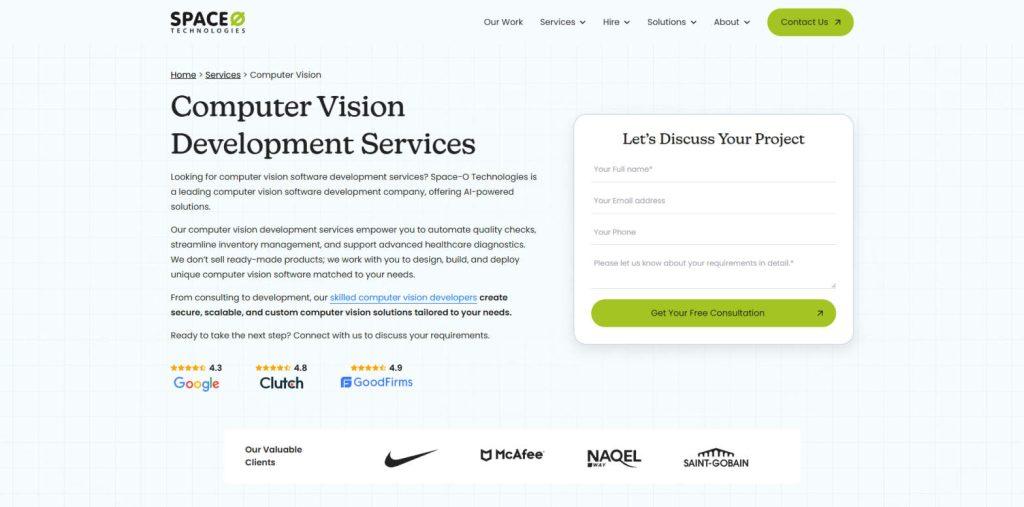
With over 15 years of experience in artificial intelligence and 500+ successful AI projects delivered worldwide, Space-O AI has established itself as a trusted computer vision development company. The company specializes in building intelligent visual systems that help businesses automate processes, enhance accuracy, and gain real-time insights from visual data.
Space-O AI’s computer vision solutions span a wide range of use cases, from facial recognition and object detection to video analytics, defect detection, and autonomous monitoring systems. Their team of AI engineers, data scientists, and ML specialists leverages advanced frameworks like OpenCV, TensorFlow, PyTorch, and YOLO, ensuring every project meets the highest standards of speed, precision, and scalability.
Space-O AI delivers end-to-end development support, starting from strategic computer vision consulting services and data preparation to model training, system integration, and real-world deployment. The company’s agile delivery process and transparent communication model have made it a preferred partner for startups and enterprises alike.
| Company Overview | Details |
| Clutch Rating | 4.8/5 ⭐ |
| Years of Experience | 15+ |
| Founded | 2010 |
| Team Size | 80+ |
| Hourly Rate | $25–$50/hr |
| Minimum Project Size | $10,000+ |
| Notable Clients | Nike, McAfee, SAINTGOBAIN |
| Industries Served | Healthcare, Retail, Manufacturing, Security & Surveillance, Real Estate, Transportation |
Build Smarter Computer Vision Solutions with Space-O AI.
Partner with Space-O AI to design and deploy custom computer vision systems that enhance automation, accuracy, and real-time decision-making across industries.
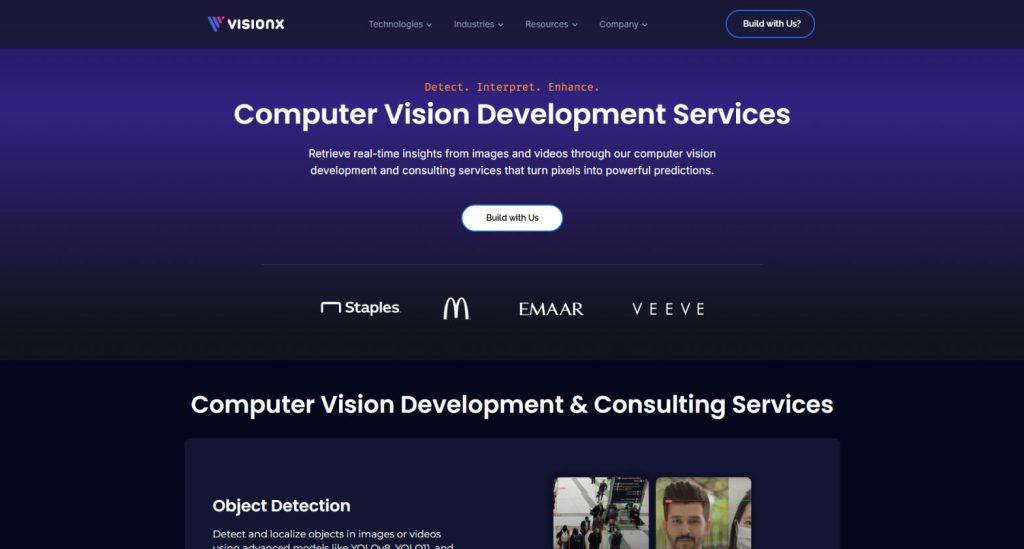
VisionX is a New York-based AI development company founded in 2017, specializing in computer vision solutions for businesses across multiple industries. The company works with modern architectures and frameworks to deliver image classification, facial recognition, and video analysis systems.
VisionX works with advanced architectures such as YOLOv8, YOLO11, Vision Transformers, and Vision Language Models (VLMs). The agency uses PyTorch, TensorFlow, and Keras to deploy these models across AWS, Azure, and GCP, including edge computing solutions for IoT and mobile devices.
With a 4.9 Clutch rating, the company focuses on rapid prototyping and MVP development for startups and enterprises across healthcare, security, manufacturing, retail, safety equipment, and education sectors.
| Company Overview | Details |
| Clutch Rating | 4.9/5 ⭐ |
| Team Size | 51–249 employees |
| Hourly Rate | $25–$49/hr |
| Minimum Project Size | $25,000+ |
| Headquarters | New York, USA |
| Notable Clients | Accenture, EMAAR |
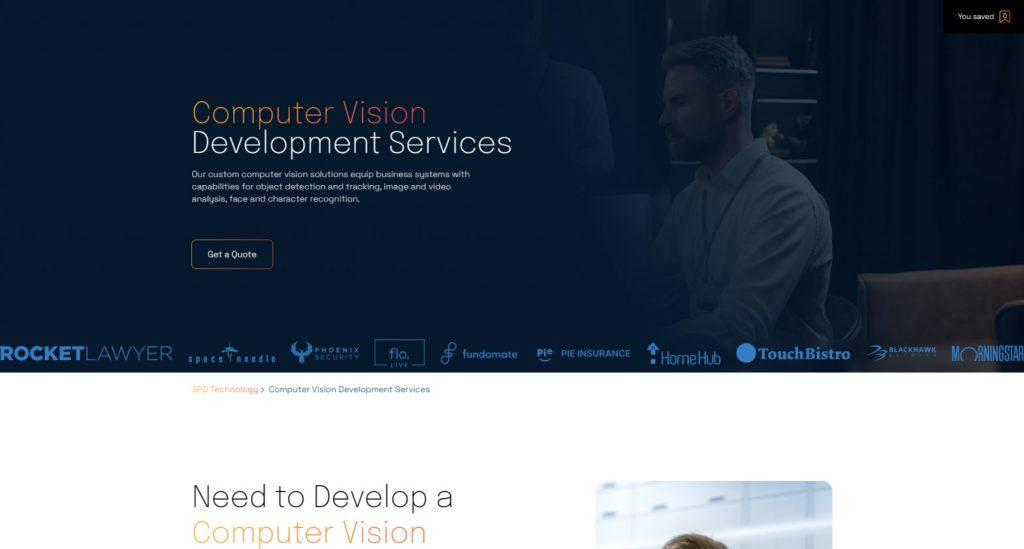
SPD Technology is a London-based software development company with global delivery capabilities. Founded in 2006, they provide computer vision solutions backed by R&D capabilities and enterprise-grade infrastructure for clients in regulated industries.
SPD Technology builds computer vision solutions for industrial defect detection, drone-based equipment inspection, biometric authentication systems, and retail inventory monitoring. Their team works with OpenCV, TensorFlow, and PyTorch to develop object detection and image analysis applications.
| Company Overview | Details |
| Clutch Rating | 4.8/5 ⭐ |
| Team Size | 250–999 |
| Hourly Rate | $50–$99/hr |
| Minimum Project Size | $50,000+ |
| Headquarters | London, UK (with global offices) |
| Notable Clients | PitchBook, Morningstar, Roche |
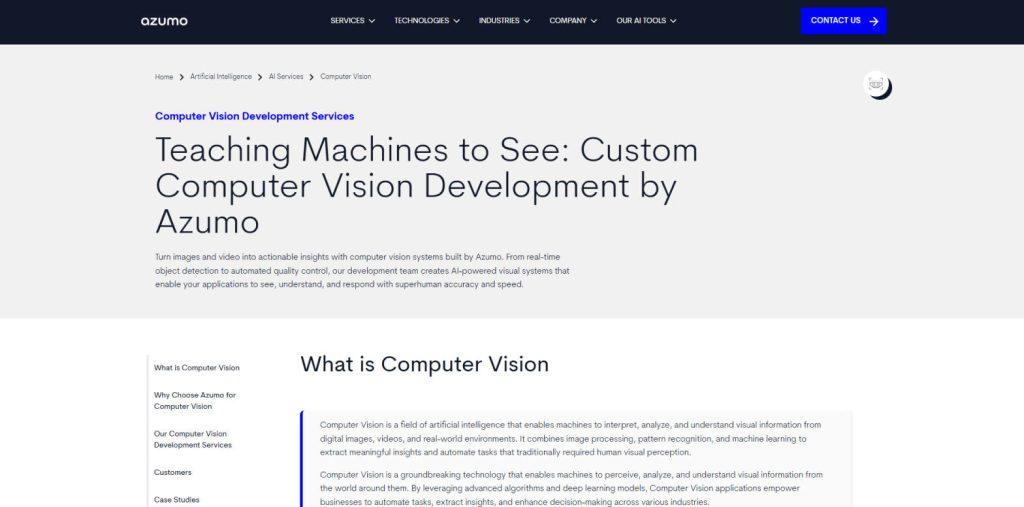
Azumo brings technical expertise in computer vision development with flexible engagement models. Founded in 2009, their developers specialize in Python, TensorFlow, PyTorch, and OpenCV across both edge computing solutions and cloud-native deployments on AWS, Azure, and GCP.
For Meta, they successfully built a custom AI-based enterprise search solution using Named Entity Recognition, demonstrating their capability to handle complex, enterprise-scale computer vision challenges. Azumo’s clients appreciate their responsive communication and flexible approach. The team adapts quickly to changing project requirements while maintaining technical excellence.
| Company Overview | Details |
| Clutch Rating | 4.9/5 ⭐ |
| Team Size | 50–249 |
| Hourly Rate | $25–$49/hr |
| Minimum Project Size | $10,000+ |
| Headquarters | San Francisco, CA |
| Notable Clients | Meta, Zynga, United Healthcare |
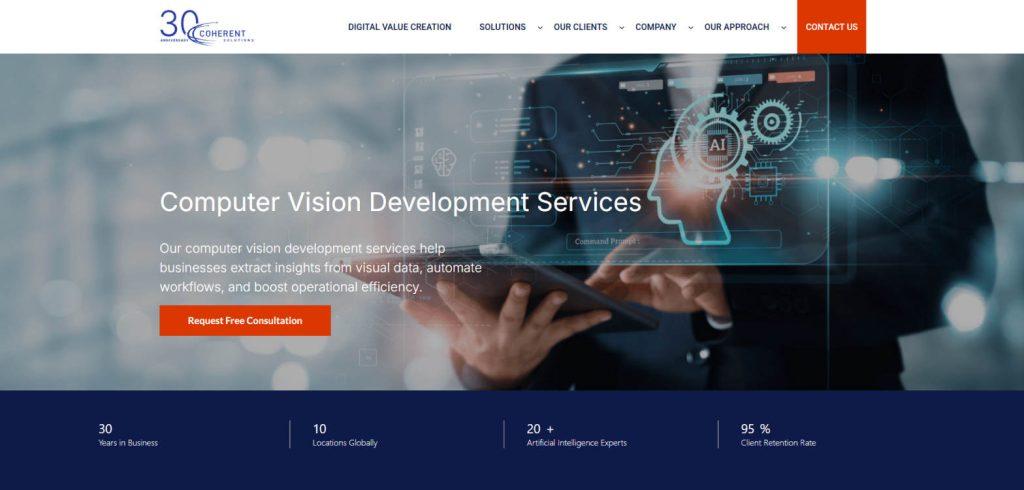
Founded in 1995, Coherent Solutions has built three decades of software engineering expertise with a specialized focus on enterprise-grade computer vision development. Their recent recognition by Clutch as a 2025 Spring Global Award winner for AI, NLP, and Robotics services validates their position as a leader in the field.
Working with advanced architectures, including CNNs, RNNs, Vision Transformers, and GANs through TensorFlow, PyTorch, and Keras, they tackle complex computer vision challenges that require sophisticated approaches. ISO certifications make them particularly well-suited for regulated industries where compliance isn’t optional.
| Company Overview | Details |
| Clutch Rating | 4.7/5 ⭐ |
| Team Size | 1,000–9,999 |
| Hourly Rate | $50–$99/hr |
| Minimum Project Size | $50,000+ |
| Headquarters | Minneapolis, MN |
| Notable Clients | ANYTIME FITNESS, LIFE TIME, wex |
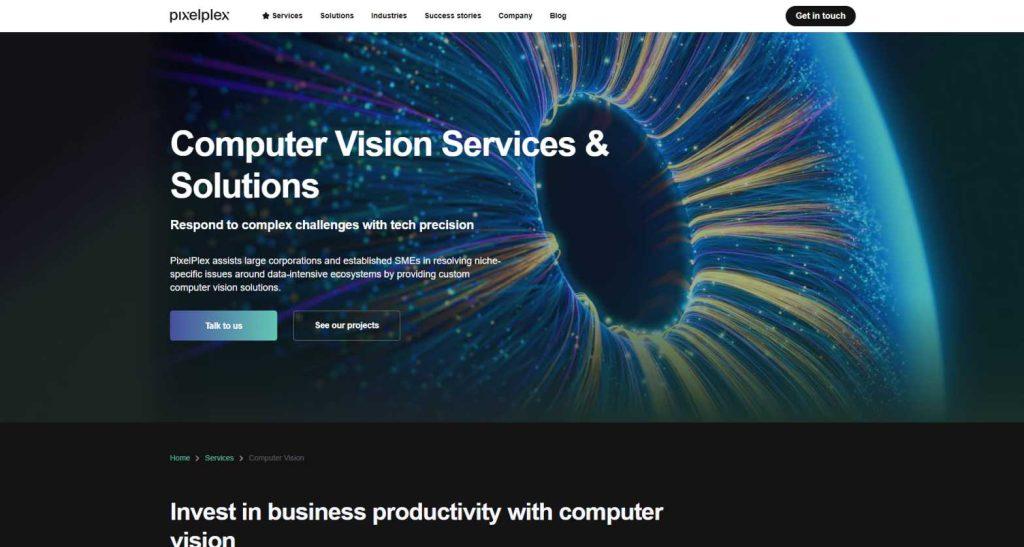
Since its launch in 2007, PixelPlex has established itself as an innovator in combining computer vision with emerging technologies like blockchain, IoT, and AR/VR. Working with Python, TensorFlow, PyTorch, and Keras, they’ve built solutions for some of the world’s most innovative companies.
Their client roster, spanning Microsoft, BMW, Kakao, and Disney, speaks to their ability to deliver at the highest levels across diverse industries and use cases. Clutch has recognized them multiple times for excellence in AI services. PixelPlex brings both innovation and reliability to the table.
| Company Overview | Details |
| Clutch Rating | 4.9/5 ⭐ |
| Team Size | 300+ professionals |
| Hourly Rate | $50 – $99/hr |
| Minimum Project Size | $25,000+ |
| Headquarters | New York, USA |
| Notable Clients | Microsoft, BMW, Kakao, Disney |
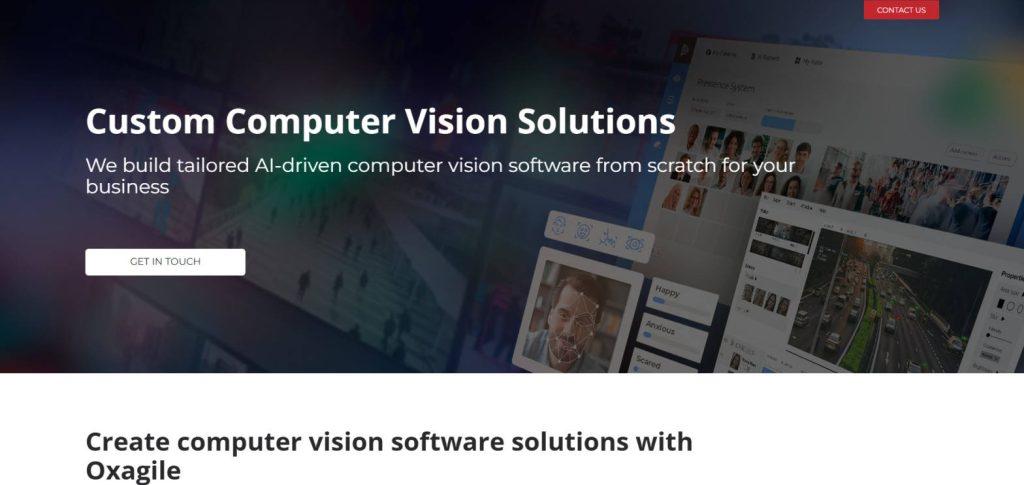
Established in 2005, Oxagile has spent two decades carving out a unique niche by combining deep computer vision expertise with extensive video processing capabilities. This dual specialization creates a technical foundation that sets them apart, particularly for applications requiring sophisticated video analytics.
Their approach blends fundamental machine learning research with practical signal processing expertise using TensorFlow, PyTorch, and OpenCV. They’ve developed workplace safety solutions, security monitoring systems, and intelligent video analytics platforms that operate reliably across diverse real-world environments and challenging conditions.
Their client list, including Google, Disney, Discovery Communications, and MIT, reflects the trust major organizations place in their capabilities for video content classification, online proctoring, and anomaly detection applications.
| Company Overview | Details |
| Clutch Rating | 5.0/5 ⭐ |
| Team Size | 250–999 |
| Hourly Rate | NA |
| Minimum Project Size | NA |
| Headquarters | New York, USA |
| Notable Clients | Disney, Discovery Channel, MIT |
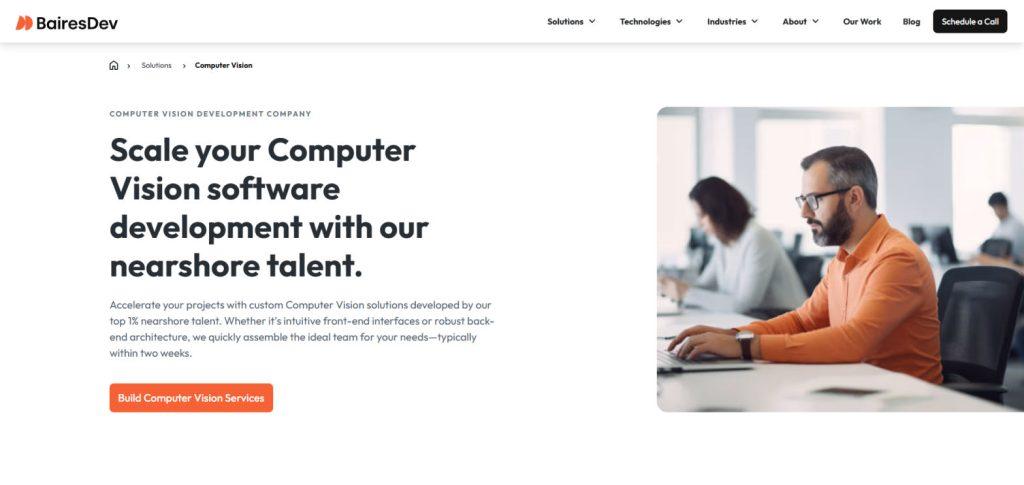
Launched in 2009, BairesDev has today grown into a powerhouse with thousands of engineers operating across multiple continents. What sets them apart is their rigorous vetting process, accepting only top-tier software engineering talent, combined with the flexibility to scale from single specialists to entire dedicated teams as project needs evolve.
Their computer vision development expertise includes Python, TensorFlow, PyTorch, and OpenCV, with particular strength in cloud infrastructure integration. This technical foundation, combined with their massive talent pool, enables them to tackle multiple simultaneous computer vision initiatives that smaller firms simply can’t handle.
| Company Overview | Details |
| Clutch Rating | 4.9/5 ⭐ |
| Team Size | 1,000–9,999 |
| Hourly Rate | $50 – $99/hr |
| Minimum Project Size | $50,000+ |
| Headquarters | San Francisco, CA |
| Notable Clients | Pinterest, Salesforce, Adobe |
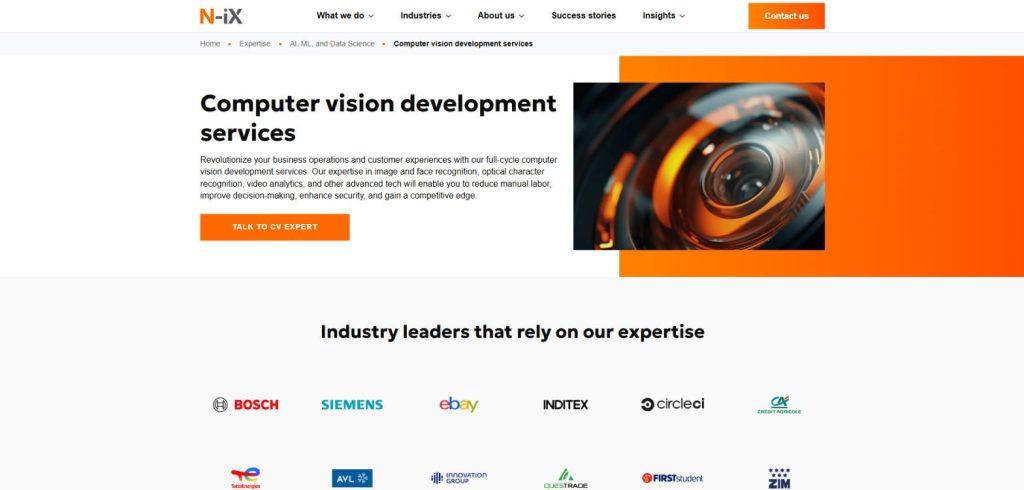
Founded in 2002, N-iX brings over two decades of software engineering experience with particular expertise in transportation and industrial computer vision applications, where accuracy and reliability are essential. Operating across 25 countries, they’ve earned recognition from Clutch as a global technology leader.
N-iX’s work for Redflex demonstrates capabilities in seatbelt detection, distracted driving identification, and license plate recognition for mission-critical applications. With expertise in TensorFlow, PyTorch, and OpenCV across AWS, GCP, and Azure, they handle complex enterprise computer vision projects requiring high reliability.
| Company Overview | Details |
| Clutch Rating | 4.8/5 ⭐ |
| Team Size | 1,000–9,999 |
| Hourly Rate | $50–$99/hr |
| Minimum Project Size | $100,000+ |
| Headquarters | Multiple locations across 25 countries |
| Notable Clients | BOSCH, SIEMENS, eBay |
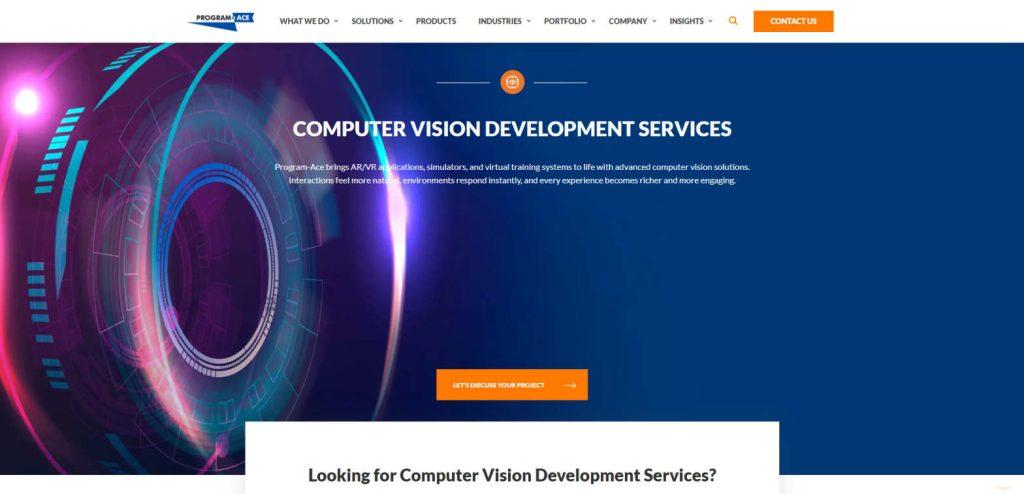
With roots dating back to 1992, Program-Ace is one of the most experienced companies on this list, bringing over three decades of innovation to computer vision development. They specialize in integrating computer vision with XR (AR/VR/MR) technologies for training simulations and interactive applications.
Their technical practice uses Unity, Unreal Engine, TensorFlow, PyTorch, and OpenCV, bridging game engine technology with AI frameworks. For Gap Inc., Program-Ace has delivered safety training simulations, improving employee readiness across stores, offices, and distribution centers. Their expertise spans gesture recognition, motion tracking, and real-time visual data processing.
| Company Overview | Details |
| Clutch Rating | 4.8/5 ⭐ |
| Team Size | 50–249 |
| Hourly Rate | $50–$99/hr |
| Minimum Project Size | $75,000+ |
| Headquarters | Cyprus |
| Notable Clients | Unity, GAP, namco |
This concludes our list of the top computer vision development companies. Next, discuss the critical factors you should consider when making your final choice.
Choosing the right computer vision development partner isn’t just about picking the company with the highest Clutch rating or the biggest client list. It’s about finding the team that aligns with your specific needs, budget, and vision. Here are a few factors to consider while choosing a computer vision development partner:
Define your needs clearly before reaching out: real-time object detection, facial recognition, or document analysis? Identify accuracy requirements, processing speed, deployment environment, and compliance needs. This clarity helps you match with companies that have relevant expertise and experience.
Look beyond buzzwords and examine each vendor’s technology stack. Do they work with modern frameworks like YOLO11 and Vision Transformers? Ask about their experience with similar projects and how they’ve solved challenges in your specific domain.
Examine what companies have actually built, not just who they’ve worked with. Look for production systems handling real-world data volumes, not just proof-of-concepts. Pay attention to projects similar to yours across relevant industries.
Pricing varies based on location, expertise, and engagement model. Match your budget to minimum project sizes, which range from smaller to enterprise-level investments. Consider total cost, including deployment, maintenance, ongoing optimization, and future scaling expenses.
Assess communication style during initial conversations. Do they explain technical concepts clearly? Ask about update frequency, collaboration tools, and how they handle scope changes. Responsive communication and flexibility are critical for complex projects.
Check for relevant certifications like SOC 2 compliance or ISO 27001. Ask about data handling practices and how they address GDPR, HIPAA, or industry-specific regulations. Security breaches in computer vision systems can have severe consequences.
Ensure your partner can scale systems from thousands to millions of images daily. Ask about cloud infrastructure experience and post-deployment support options. Look for maintenance agreements and uptime guarantees to ensure reliability.
500+ AI Projects. One Trusted Computer Vision Partner.
From image recognition to predictive analytics, Space-O AI has the experience, team, and technology to turn complex computer vision ideas into production-ready solutions.
Choosing the right computer vision development partner can make or break your AI project. The companies we’ve covered each bring unique strengths, from rapid prototyping and enterprise-scale deployment to specialized solutions that combine computer vision with emerging technologies.
But the “best” company isn’t always the one with the largest team or the highest ratings. The right partner is the one that truly understands your business challenges, has proven industry expertise, and delivers measurable results that align with your goals and budget.
That’s where Space-O AI comes in. With 15+ years of experience as an AI development company and 500+ AI projects delivered, we offer end-to-end computer vision development services. From feasibility assessments and strategic roadmap planning to solution design and implementation, we transform visual data into actionable insights that deliver real business impact.
Get your free consultation today and partner with Space-O AI to bring your computer vision project to life.
Computer vision development services costs vary based on project complexity, team location, and features. Hourly rates range from $25 to $99, while minimum project sizes span $10,000 for basic implementations to $100,000+ for enterprise deployments.
Development timelines depend on project complexity. A basic proof-of-concept typically takes 6–12 weeks for assessment, data preparation, and initial testing. Production-ready systems require 3–6 months, including comprehensive data collection, model training, testing, and deployment.
Enterprise-scale implementations take 6–12+ months with extensive data engineering and phased rollout. Rapid prototyping can deliver working models in weeks to validate feasibility.
Ask about their experience with similar projects and request relevant case studies. Inquire about the development process, timeline estimates, and team structure. Discuss data requirements and technology stack recommendations. Clarify communication protocols and update frequency.
Local companies offer easier communication and similar time zones, but higher rates. Offshore developers provide cost advantages and global talent access, but may have timezone differences.
Nearshore options balance cost with timezone alignment. Consider project complexity, budget, communication preferences, and collaboration needs. Many successful projects use hybrid models combining local management with offshore development when planning to hire computer vision developers.
Reputable companies implement secure data transmission, encrypted storage, access controls, and regulatory compliance (GDPR, HIPAA). They sign NDAs and provide clear data handling policies. Check for certifications like SOC 2 or ISO 27001.
Ask about infrastructure security, data usage policies, and deletion procedures. For sensitive applications, consider on-premise or private cloud deployment options.
Request proof-of-concept projects before full engagement. Review case studies, technical blog posts, and team credentials. Ask about development processes, testing methodologies, and quality assurance. Verify partnerships with AWS, Google Cloud, or NVIDIA.
Check for industry recognition and awards. Consider technical interviews with lead developers. Start with smaller projects to evaluate capabilities before larger commitments.
Build Your Vision with AI Experts
What to read next